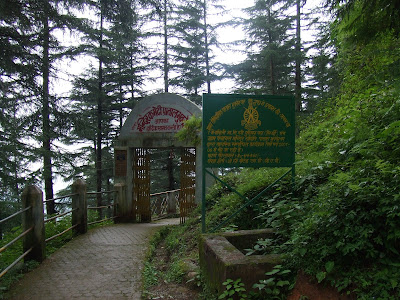PATAL BHUVNESHWAR-
Patal Bhuvneshwar is an unique cave temple located in the Pithoragarh district of Uttarakhand. This religious place is dedicated to several deities and said to be as old as the universe it self .During our visit to the Patal Bhuvneshwar,we stayed in the Parvti Resorts located in the nearby Bhuvneshwar village It is believed that a visit to this cave temple in Patal Bhuvneshwar is as important as the visit of Char Dham. The cave is located in a very picturesque surrounding having " Devdar" trees all around.The cave is under A.S.I.(Archaeological Survey of India ) regulations and it is not allowed to carry the mobile phone, digital camera etc inside the cave and visitors have to deposit such electronic gadget in the front office, managed by the temple committee.Guide facility is also available for which a prescribed fees of Rs.50/- is taken and a printed receipt is issued.The main temple is in 'Patal" and is about one hundred ft.under the ground .The devotees have to pass through a narrow and uneven downward tunnel with the support of iron chains to reach the main cave temple.
It is believed that here, the whole of the Bhuvan (Universe) has been created by Lord himself. While passing through the cave,our guide showed us sacred idols and representation of several God and Goddess. Some of them are as follows-
Sheshnag,Takshak&.Vasuki
Ashta Kamal,Ganeshji,
Eravat,having 1000 legs,Kamdhenu& Parijat tree.
Tongue of Kal Bhairav
Jatayu , Garud
Mund of Mundmal and Farsa.
Havan Kund erected by Vishwarma
Panch Kedar,Badrinathji and Amarnathji
Brahmaji ka kapal and the milk pouring over this Kapal .
Long hair (Jataiyen) of Lord Shiva,and the Gangaji emerging from them.
Narvadeshwar and the thirty three corores Devtas.
Seat (Ashan) of Saptarishi.
Four Yug,namely -Satyug, Tretayug, Dwaparyug and Kaliyug in which Kaliyug is growing with the passage of time.
Brahma,Vishnu and Mahesh.
Seventh Kund of Saptakund being filled by the droplets of Amrit and simultaneous fall of overflowing amrit downwards.
Shivling, who is being worshipped at present and where rituals are being performed every morning.
However students of science, may interpret them as to be the limestone rock formations or stalagmite.
However students of science, may interpret them as to be the limestone rock formations or stalagmite.
The main cave leads to several other caves.The entrance of two caves emerging from this cave temple known as "Pap Dwar" and "Ran Dwar"are presently closed with huge rock stones.It is believed that the Pap Dwar was closed after the Lord Rama killed Ravana and the Ran Dwar was closed after the defeat of Kauravas in the famous battle of Mahabharat. Our guide told us that there are other caves leading to "Char Dham " located in the four corners of India.
The facts about the discovery of this temple have been written on a stone board near the main entrance.It is believed that during the "Treta Yug", king Ritupurna of Ayodhya was the first fortunate person to enter in this cave and during his visit the Sheshnag accompanied and guided him in this cave temple.It is said that Pandavas were the next human beings who could reach and enter in this cave temple ,there after the cave remained closed during the whole Dwapar Yug .During the "Kali Yug",when Shankaracharya explored the religious places in Himalaya, he rediscovered this cave temple and there after the local rulers took the responsibility of regular worship and rituals ,which is still being performed by the local "Bhandari" community, from one generation to another.
Some of the photographs of the Patal Bhuvneshwar are as follows-





